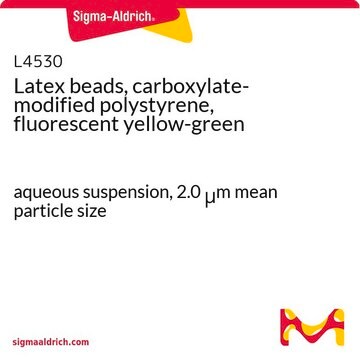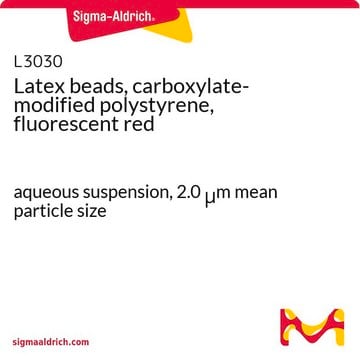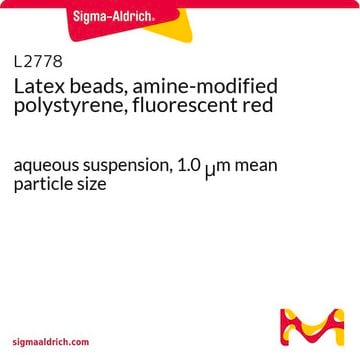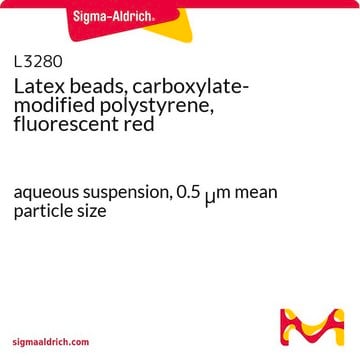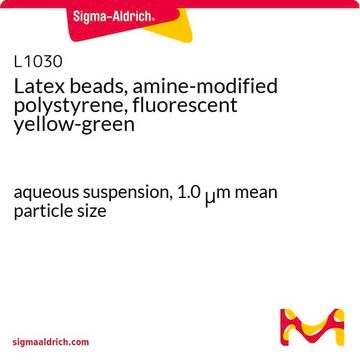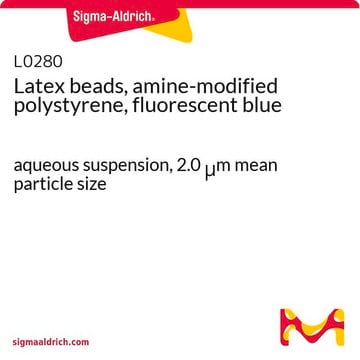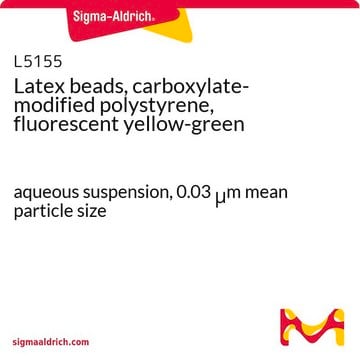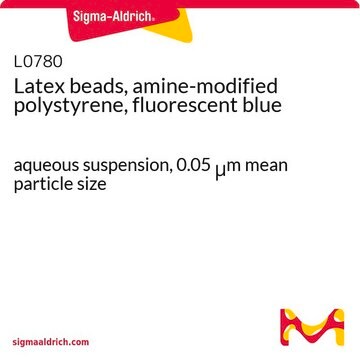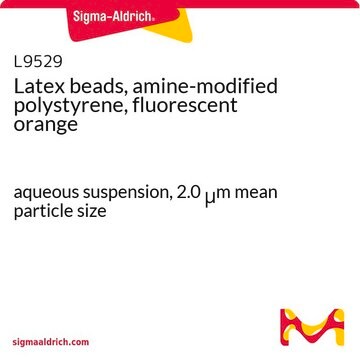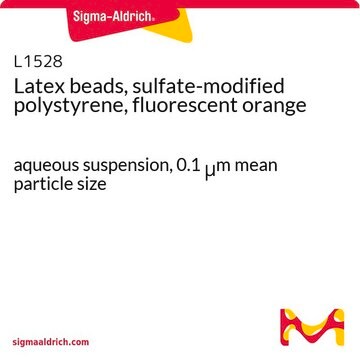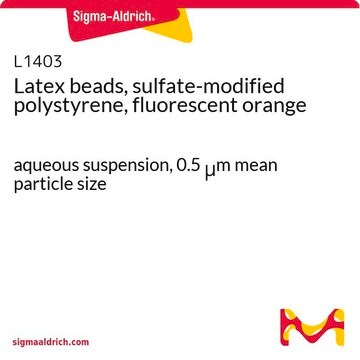The concentration of the Latex Beads is approximately 4.75x10^10 beads/mL.
L4655
Latex-Beads, carboxylatmodifiziertes Polystyrol, gelb-grün fluoreszierend
aqueous suspension, 1.0 μm mean particle size
Synonym(e):
Fluorescent Latex Beads
Größe auswählen
About This Item
Empfohlene Produkte
Form
aqueous suspension
Qualitätsniveau
Zusammensetzung
Solids, 2.5%
Methode(n)
cell based assay: suitable
Mittlere Partikelgröße
1.0 μm
Fluoreszenz
λex ~470 nm; λem ~505 nm
Eignung
suitable for immunoassay
Anwendung(en)
cell analysis
Suchen Sie nach ähnlichen Produkten? Aufrufen Leitfaden zum Produktvergleich
Anwendung
- bei der Herstellung von Konjugaten mit dem epidermalen Wachstumsfaktor für Studien mit Bildgebung mittels indirekter Immunfluoreszenz[1]
- zum Kultivieren von bronchoalveolären Makrophagen sowie von Makrophagen, die aus menschlichen Monozyten gewonnen wurden, vor Bildgebungsstudien zur Phagozytose[2]
- gemeinsam mit von Salmonella exprimiertem, grün fluoreszierendem Protein (GFP) für konfokale mikroskopische Untersuchungen und in der Biofluoreszenz-Bildgebung[3]
Lagerklassenschlüssel
10 - Combustible liquids
WGK
WGK 3
Flammpunkt (°F)
Not applicable
Flammpunkt (°C)
Not applicable
Hier finden Sie alle aktuellen Versionen:
Besitzen Sie dieses Produkt bereits?
In der Dokumentenbibliothek finden Sie die Dokumentation zu den Produkten, die Sie kürzlich erworben haben.
Kunden haben sich ebenfalls angesehen
-
What is the concentration of product L4655?
1 Antwort-
Hilfreich?
-
-
What are the ingredients of the solution in which the plastic is diluted? Can I dilute it in PBS?
1 Antwort-
This product is prepared in water containing a prioprietary anionic surfactant and >0.1% Sodium Azide. Phosphate Buffered Saline is a suitable diluent.
Hilfreich?
-
-
Are there latex beads recommended for phagocytosis, and if so, what size is recommended?
1 Antwort-
There is no performance testing of latex beads for phagocytosis. Information found indicates that internally, there are no specific protocols or recommendations for a phagocytosis method using the listed latex beads. However, references to literature where the products have been used in research are provided. The maximum excitation and emission for one of the latex bead products, L3280, are also mentioned. Additionally, three products (catalog numbers 59769, 43302, and 89904) were found on the company website, with variations in bead size and fluorescence. For more details, you may refer to the provided links and Knowledge Article 000007596.
Hilfreich?
-
-
What are the differences between carboxylate-modified polystyrene and amine-modified polystyrene Latex beads, and which type of beads is suitable for phagocytosis applications?
1 Antwort-
When selecting beads for phagocytosis assays, there are three key parameters to consider: the size of the bead, the color of the bead (dyed or undyed), and the modification of the bead (carboxylate, amine, or sulfate modified).
Beads chosen for phagocytosis experiments typically range from approximately 0.5 to 3 micrometers in size. A 1:250 dilution of the beads into the culture medium is commonly used for phagocytosis experiments. Latex Beads, 2 um (Product No. L0905), can be utilized for phagocytosis assays, as macrophages can phagocytose particles larger than 2 um.
Fluorescent latex beads are available with different fluorescent dyes incorporated into the beads. The yellow-green beads are commonly used for phagocytosis studies and are compatible with most flow cytometers and fluorescent microscopes.
For phagocytosis applications, the choice of bead modification (carboxylate vs. amine) depends on the specific assay being conducted. Carboxylate-modified beads, with a negative charge, mimic the uptake of apoptotic cells, while amine-modified beads, with a positive charge, are used to mimic the uptake of opsonized cells.
Hilfreich?
-
-
What is the recommended storage temperature?
1 Antwort-
This product may be stored at room temperature. For products with no specified storage temperature given on the label or product page, ambient storage may be assumed. Products that require controlled temperature storage, such as refrigeration or freezer conditions, storage temperatures are published on the product label, Certificate of Analysis, the Safety Data Sheet (SDS).
Hilfreich?
-
Aktive Filter
Unser Team von Wissenschaftlern verfügt über Erfahrung in allen Forschungsbereichen einschließlich Life Science, Materialwissenschaften, chemischer Synthese, Chromatographie, Analytik und vielen mehr..
Setzen Sie sich mit dem technischen Dienst in Verbindung.